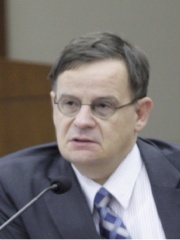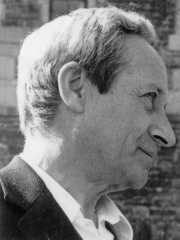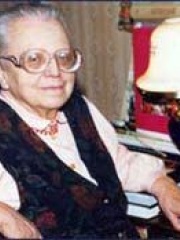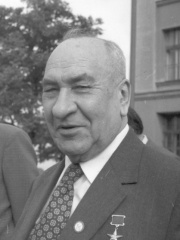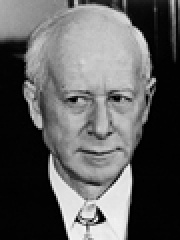
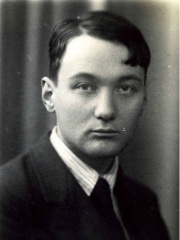
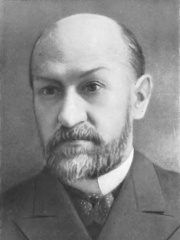
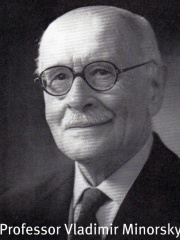
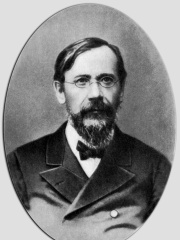
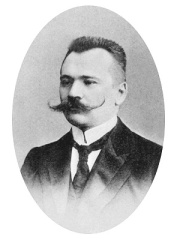
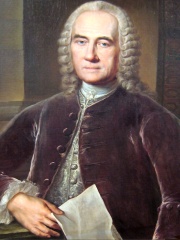
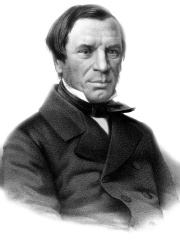
The Most Famous
HISTORIANS from Russia
This page contains a list of the greatest Russian Historians. The pantheon dataset contains 561 Historians, 22 of which were born in Russia. This makes Russia the birth place of the 7th most number of Historians behind Türkiye, and Italy.
Top 10
The following people are considered by Pantheon to be the top 10 most legendary Russian Historians of all time. This list of famous Russian Historians is sorted by HPI (Historical Popularity Index), a metric that aggregates information on a biography's online popularity. Visit the rankings page to view the entire list of Russian Historians.

1. George Ostrogorsky (1902 - 1976)
With an HPI of 68.06, George Ostrogorsky is the most famous Russian Historian. His biography has been translated into 32 different languages on wikipedia.
George Alexandrovich Ostrogorsky (Russian: Георгий Александрович Острогорский, romanized: Georgiy Aleksandrovich Ostrogorskiy; Serbian: Георгије Александрович Острогорски, Georgije Aleksandrovič Ostrogorski; 19 January 1902 – 24 October 1976) was a Russian-born, Yugoslav historian and Byzantinist who was widely known for his achievements in Byzantine studies. He was a professor at the University of Belgrade.

2. Lev Gumilyov (1912 - 1992)
With an HPI of 65.94, Lev Gumilyov is the 2nd most famous Russian Historian. His biography has been translated into 47 different languages.
Lev Nikolayevich Gumilev (also Gumilyov; Russian: Лев Никола́евич Гумилёв; 1 October [O.S. 18 September] 1912 – 15 June 1992) was a Soviet and Russian historian, ethnologist, anthropologist and translator. He had a reputation for his highly unorthodox theories of ethnogenesis and historiosophy. He was an exponent of Eurasianism.

3. Vasily Bartold (1869 - 1930)
With an HPI of 65.69, Vasily Bartold is the 3rd most famous Russian Historian. His biography has been translated into 26 different languages.
Vasily Vladimirovich Bartold (Russian: Васи́лий Влади́мирович Барто́льд; 15 November [O.S. 3 November] 1869 – 19 August 1930), who published in the West under his German baptismal name, Wilhelm Barthold, was a Russian orientalist who specialized in the history of Islam and the Turkic peoples (Turkology).

4. Vladimir Minorsky (1877 - 1966)
With an HPI of 63.78, Vladimir Minorsky is the 4th most famous Russian Historian. His biography has been translated into 25 different languages.
Vladimir Fyodorovich Minorsky (Russian: Владимир Фёдорович Минорский; 5 February [O.S. 24 February] 1877 – 25 March 1966) was a White Russian academic, historian, and scholar of Oriental studies, best known for his contributions to the study of history of Iran and the Iranian peoples such as Persians, Lurs, and Kurds in addition to the Kartvelian Laz people.
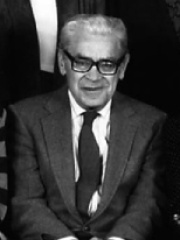
5. Alexander Kazhdan (1922 - 1997)
With an HPI of 61.71, Alexander Kazhdan is the 5th most famous Russian Historian. His biography has been translated into 26 different languages.
Alexander Petrovich Kazhdan (Russian: Алекса́ндр Петро́вич Кажда́н, romanized: Aleksándr Petróvich Kazhdán, IPA: [ɐlʲɪkˈsandr pʲɪˈtrovʲɪt͡ɕ kɐʐˈdan]; 3 September 1922 – 29 May 1997) was a Soviet and American Byzantinist. Among his publications was the three-volume Oxford Dictionary of Byzantium, a comprehensive encyclopedic work containing over than 5,000 entries.

6. Vasily Klyuchevsky (1841 - 1911)
With an HPI of 60.68, Vasily Klyuchevsky is the 6th most famous Russian Historian. His biography has been translated into 30 different languages.
Vasily Osipovich Klyuchevsky (Russian: Василий Осипович Ключевский; 28 January [O.S. 16 January] 1841 – 25 May [O.S. 12 May] 1911) was a leading Russian Imperial historian of the late imperial period. He also addressed the contemporary Russian economy in his writings.

7. Alexander Vasiliev (1867 - 1953)
With an HPI of 60.49, Alexander Vasiliev is the 7th most famous Russian Historian. His biography has been translated into 18 different languages.
Alexander Alexandrovich Vasiliev (Russian: Алекса́ндр Алекса́ндрович Васи́льев; 4 October 1867 (N.S.) – 30 May 1953) was a Russian historian. He was considered the foremost authority on Byzantine history and culture in the mid-20th century. His History of the Byzantine Empire (vol. 1–2, 1928) remains one of a few comprehensive accounts of the entire Byzantine history, on the par with those authored by Edward Gibbon and Fyodor Uspensky.

8. Jacob Theodor Klein (1685 - 1759)
With an HPI of 58.83, Jacob Theodor Klein is the 8th most famous Russian Historian. His biography has been translated into 15 different languages.
Jacob Theodor Klein (nickname Plinius Gedanensium; 15 August 1685 – 27 February 1759) was a German jurist, historian, botanist, zoologist, mathematician and diplomat in service of Polish King August II the Strong. He established a botanical garden and menagerie in Danzig apart from setting up a cabinet of natural history known as the Museum Kleinianum which he filled with specimens collected through a wide network.

9. Mikhail Pogodin (1800 - 1875)
With an HPI of 58.30, Mikhail Pogodin is the 9th most famous Russian Historian. His biography has been translated into 22 different languages.
Mikhail Petrovich Pogodin (Russian: Михаи́л Петро́вич Пого́дин; 23 November [O.S. 11 November] 1800 – 20 December [O.S. 8 December] 1875) was a Russian historian and journalist who, jointly with Nikolay Ustryalov, dominated the national historiography between the death of Nikolay Karamzin in 1826 and the rise of Sergey Solovyov in the 1850s. He is best remembered as a staunch proponent of the Normanist theory of Russian statehood. Pogodin's father was a serf housekeeper of Count Stroganov, and the latter ensured Mikhail's education at Moscow University. As the story goes, Pogodin the student lived from hand to mouth, because he spent his whole stipend on purchasing new volumes of Karamzin's history of Russia. Pogodin's early publications were panned by Mikhail Kachenovsky, a Greek who held the university chair in Russian history. Misinterpreting Schlözer's novel teachings, Kachenovsky declared that "ancient Russians lived like mice or birds, they had neither money nor books" and that Primary Chronicle was a crude falsification from the era of Mongol ascendancy. His teachings became exceedingly popular, spawning the so-called sceptical school of imperial historiography. In 1823, Pogodin completed his dissertation in which he debunked Kachenovsky's idea of the Khazar origin of Rurikid princes. He further stirred up the controversy by proclaiming that serious scholars should not only trust but worship Nestor. The dispute ended with Kachenovsky's chair being devolved on Pogodin. In the 1830s and 1840s he augmented his reputation by publishing many volumes of obscure historical documents and the last part of Mikhail Shcherbatov's history of Russia. Towards the end of the 1830s, Pogodin turned his attention to journalism, where his career was likewise a slow burner. Between 1827 and 1830 he edited The Herald of Moscow with Alexander Pushkin as one of the regular contributors. Upon first meeting the great poet in 1826, Pogodin remarked in his diary that "his mug doesn't look promising". However, this remark is usually taken out of context as Pogodin wrote glowing reviews of Pushkin's work as early as 1820. In the wake of the Polish Uprising it fell to Nicholas I's minister of education, Count Uvarov to find ways to unite the various branches of the "true Russians". Uvarov began looking for an author who could provide historical justification for the annexation and integration of the new western provinces into the empire. Uvarov's first choice was Pogodin, who was approached in November 1834 and submitted his work in 1835, however his work did not satisfy the minister's demands nor the tsar's, as his book presented the history of northeastern Rus (Russia) as too distinct and separate from the history of Southern Rus (Ukraine), undermining the project's main goal. In the report of the investigations into the actives of the Brotherhood of Saints Cyril and Methodius, professors Mikhail Pogodin and Stepan Shevyrev were named as key figures in the Slavophile movement. However, though a key figure in the emerging pan-Slavic movement by stressing the unique and self-awareness of the Russian nation, Pogodin set an example to non-Russian Slavs who wished to celebrate their distinctness and consequently their rights to autonomy and independence. From its beginning, Ukraine took a special place in the Slavophile movement. Pogodin and Shevyrev both showed a great interest in the culture and history of Ukraine in particular. Podogin saw cultural differences between Russians and Ukrainians that went beyond language and history. He wrote in 1845, "The Great Russians live side by side with the Little Russians, profess one faith, have shared one fate and for, for many years one history. But how many differences there are between the Great Russians and the Little Russians". In the 1840s, Pogodin suggested that there had been linguistic differences among the population as early as Kievan times, and that they coincide with 19th century's distinctions between Great Russians and Little Russians. Thus, while the population of Kiev, Chernihiv and Halych spoke Little Russian, that of Moscow and Vladimir spoke Great Russian. What more, he considered the Princes of Kiev, including such a major figure in the development of the Grand Duchy of Moscow as Andrei Bogoliubsky, to have been Little Russians. According to Pogodin it was only Bogoliubsky's descendants he argued that had "gone native" in the north-eastern lands and became Great Russians. According to historian Serhii Plokhy "Pogodin's account of Kievan Rus history deprived the early Great Russian narrative of its most prized element—the Kievan period". Pogodin drastically changed his analysis of Kievan Rus and of Russian nationalism after the arrest of his pro-Ukrainian associate Mykola Kostomarov and the remaining members of the Brotherhood of Saints Cyril and Methodius. In his 1851 letter to Sreznevsky, Pogodin asserted that in reading the early Kievan Chronicles he detected no trace of the Little Russian language but rather of the Great Russian language, consciously or unconsciously aware of the fact that the chronicles had not been written in Old East Slavic but Church Slavonic. In 1841 Pogodin joined his old friend Stepan Shevyrev in editing Moskvityanin (The Muscovite), a periodical which came to voice Slavophile opinions. In the course of the following fifteen years of editing, Pogodin and Shevyrev steadily slid towards the most reactionary form of Slavophilism. Their journal became embroiled in a controversy with the Westernizers, led by Alexander Herzen, who deplored Pogodin's "rugged, unbroomed style, his rough manner of jotting down cropped notes and unchewed thoughts". Pogodin's main focus during the last segment of his scholarly career was on fending off Kostomarov's attacks against the Normanist theory. By that period, he championed the pan-Slavic idea of uniting Western Slavs under the aegis of the tsars and even visited Prague to discuss his plans with Pavel Jozef Šafárik and František Palacký. In the 1870s he was again pitted against a leading historian, this time Dmitry Ilovaisky, who advocated an Iranian origin of the earliest East Slavic rulers. His grandson Mikhail Ivanovich Pogodin (1884–1969) was a museologist.
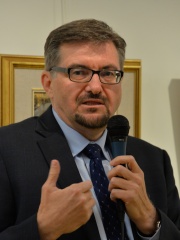
10. Serhii Plokhy (b. 1957)
With an HPI of 57.99, Serhii Plokhy is the 10th most famous Russian Historian. His biography has been translated into 22 different languages.
Serhii Mykolayovych Plokhy (Ukrainian: Сергій Миколайович Плохій; born 23 May 1957) is a historian and author. He is the Mykhailo Hrushevsky professor of Ukrainian history at Harvard University, where between 2013 and 2025 he also served as the director of the Harvard Ukrainian Research Institute.
People
Pantheon has 22 people classified as Russian historians born between 1685 and 1963. Of these 22, 2 (9.09%) of them are still alive today. The most famous living Russian historians include Serhii Plokhy, and Andrei Lankov. The most famous deceased Russian historians include George Ostrogorsky, Lev Gumilyov, and Vasily Bartold.
Living Russian Historians
Go to all RankingsDeceased Russian Historians
Go to all RankingsGeorge Ostrogorsky
1902 - 1976
HPI: 68.06
Lev Gumilyov
1912 - 1992
HPI: 65.94
Vasily Bartold
1869 - 1930
HPI: 65.69
Vladimir Minorsky
1877 - 1966
HPI: 63.78
Alexander Kazhdan
1922 - 1997
HPI: 61.71
Vasily Klyuchevsky
1841 - 1911
HPI: 60.68
Alexander Vasiliev
1867 - 1953
HPI: 60.49
Jacob Theodor Klein
1685 - 1759
HPI: 58.83
Mikhail Pogodin
1800 - 1875
HPI: 58.30
Léon Poliakov
1910 - 1997
HPI: 57.37
Olena Apanovych
1919 - 2000
HPI: 56.65
Boris Rybakov
1908 - 2001
HPI: 56.02
Overlapping Lives
Which Historians were alive at the same time? This visualization shows the lifespans of the 18 most globally memorable Historians since 1700.

